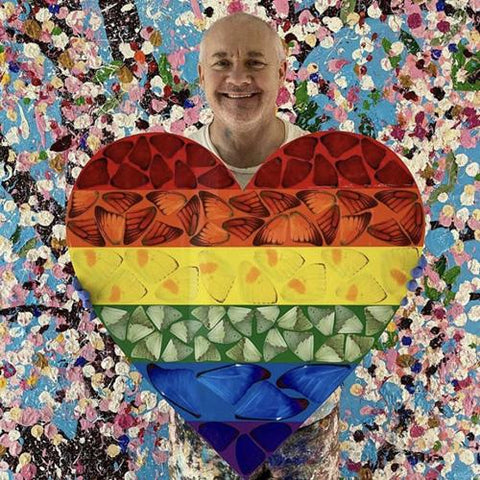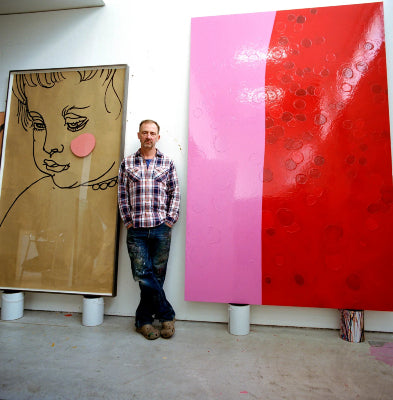35 years ago today, the doors of a Port Authority building in London’s Dockland’s were thrown open, and a new generation of artists were born - the Young British Artists (YBAs).
The student exhibition, curated by Damien Hirst, has gone down in history as an event that rewrote the rule book. To this day, the YBAs are considered some of the most ambitious and notorious figures to ever grace the art world.

Freeze opening party, showing (left to right), Ian Davenport, Damien Hirst, Angela Bulloch, Fiona Rae, Stephen Park, Anya Gallaccio, Sarah Lucas and Gary Hume.
To honour the anniversary of Freeze, we’re remembering the madness of the exhibition, the art included, and looking at a selection of the featured artists to see how their careers have gone from strength to strength.
Freeze Frame
Back in 1988, a group of artists in the second year of their studies at Goldsmiths University got fed up of being told they couldn’t expect any easy breaks, and decided to take the launch of their artistic careers into their own hands
With Hirst leading the way, the students decided to professionally-present an exhibition of their work, and invite collectors, dealers and agents to come and see it for themselves.
It was this rebellious disregard for the artistic establishment and how things were ‘usually done’, that made influential people, including Charles Saatchi, sit up and take notice. Speaking of the show, the students’ tutor, Michael Craig-Martin stated:
“People have said that Freeze was about making money but it wasn't. It was about being young, about being excited about what they were doing, and getting people to see their work.”

What’s in a Name?
Given the show captured a pivotal moment in art history, the name given to the exhibition seems incredibly prescient. In reality, it appears to have been little more than a lucky coincidence, with the artists remembering the genesis of the name very differently…which is hardly surprising given the amount of booze that was famously flowing throughout the show!
The first theory attributes the show’s name to Mat Collishaw’s piece, Bullet Hole - a series of fifteen light boxes displaying a gruesome close-up of a head wound delivered by an ice pick. The show catalogue explained the artwork as being: ‘dedicated to a moment of impact, a preserved now, a freeze frame'.

Mat Collishaw with Bullet Hole, Freeze Exhibition, July 1988. Image courtesy of Mat Collishaw
While this theory works nicely, Abigail Lane remembers things a little differently, recalling the idea coming to her, Hirst, Collishaw and Michael Landy over a lasagne…
“We were eating frisée lettuce. God knows who said what, but then it started a little conversation that led from frisée to ‘Freeze.’”
Who knows what the truth is but we think it’s a perfect summation of the devil-may-care attitude of the YBAs that one of the defining cultural moments of the 20th century could actually be named after a type of lettuce!
All Hands on Deck
Given the minimal budget, organising Freeze involved mobilising all involved to clear the building and make it show ready. The gruelling preparation took an emotional toll on the group, with bitter arguments erupting over the hang, and who should secure the best spots. Speaking of this rivalry, Fiona Rae recalls:
“I remember when one particularly grim squabble was going on during the hanging of Freeze, we turned round and Damien was sitting on the floor with his back to the wall and he had a hammer and just banged his head with it until we stopped.”
Speaking of the exhibition, participant Stephen Park states:
“I remember it as a kind of sociological experiment in which Damien played the alpha baboon. It was all about body language and status games. I also remember trying to persuade a group of us that Sarah Lucas's sculpture was not good enough to be included...”
Despite Park’s doubts, Lucas has gone on to be one of the biggest names to emerge from Freeze, known for her “brash and tender exploration of what makes us human.”
With health and safety barely registering on their list of priorities, many an injury also happened in the run up to the show. Collishaw lacerated his hands while hanging his work, Anya Gallaccio was rushed to hospital with third-degree burns after splashing molten lead into her boot while pouring her floor sculpture, and Simon Patterson trod on a rusty nail, not once, but twice.
 Image courtesy of Ian Davenport, 1988.
Image courtesy of Ian Davenport, 1988.
The Art
While the show was plagued with injuries and irritation, let’s not forget that Freeze was about the art. The show was the first to feature Hirst’s spot paintings and Ian Davenport’s experiments with applying paint to the canvas in a range of physical approaches.

Angela Bulloch sits on Damien Hirst’s lap during preparations for Freeze (Credit: Simon Patterson/Courtesy of Angela Bulloch)
Damien Hirst
The brazen audacity displayed by Hirst throughout Freeze, which involved blagging funding and picking up Norman Rosenthal, the Royal Academy’s secretary, to personally chauffeur him to the show, is a characteristic that has gone on to define his artistic career.

Hirst’s contributions to Freeze were a spot painting (pictured above) painted directly onto the wall, that reportedly remained there for two years, and a series of painted boxes stuck in a pattern on the wall. Apparently, a collector was keen to buy the boxes as one installation, but after attempting to pin them together with paper clips, Hirst reportedly smashed the whole thing up for being, ‘too annoying.’
Over the years since Hirst orchestrated his arrival onto the art scene, we’ve seen him employ many a guerrilla tactic to spark controversy, and sell art. Whether it’s sawing animals in half or burning millions of pounds of art, love him or hate him, Hirst’s rebellious attitude has arguably been responsible for making him the richest living artist on the planet.

View artworks by Damien Hirst.
Ian Davenport
One of the biggest success stories of the exhibition was Ian Davenport, who was 21 at the time of the show. Off the back of the two pieces Davenport had at Freeze, he was immediately signed by art dealer, Leslie Waddington, who still represents him to this day.

Ian Davenport 2021. Image courtesy of Ian Davenport Studio.
Since day one, Davenport has been interested in the organic nature of paint and the mesmerising ways that it drips and pours. His practice, born in the classrooms of Goldsmiths, involves unconventional techniques using everything from paint-filled hypodermic needles and watering cans, to industrial wind machines. Speaking of the experimentation that’s gone on to define his career, he states:
“The guys in the sculpture department at my art college had it right. They always seemed to be playing around and experimenting. It always struck me that the painters didn't do that, that they stuck to using materials in a conventional way.
I did all the things you're not supposed to do - you aren't meant to put oil paint and water paint together, so that's immediately the first thing I did. Of course it was totally hopeless, but I felt that breaking these rules really opened something for me. As an artist I think that you should always question what you're told.”
View artworks by Ian Davenport.
Gary Hume
Gary Hume was another artist whose career was launched at Freeze. His contribution was three life-sized paintings of hospital doors, rendered using household gloss paint he’d managed to wangle off family friends.

The paintings in question were reproductions of swing doors from inside St Bartholomew’s Hospital in East London that he first saw in a Bupa health insurance ad. Speaking of the works, Hume explains:
“The paintings pack a low blow. They have many metaphorical meanings - they're doors of perception, doors of your birth, the very first and possibly the last things you see before you die. They have a blankness that demands you invest them with some meaning.”
Charles Saatchi snapped up all three paintings featured at Freeze, and since then, Hume has created a further 50. His career also includes a Turner Prize nomination, and representing Britain at the Venice Biennale. Speaking of the exhibition, Hume states:
"There wasn't a sense that we were changing the shape of British art, necessarily but we wanted to change the given trajectory of how you became an artist: leave college, get a part-time teaching job, or a full-time teaching job - all very slow. We thought: why should we wait for this slow endorsement? Let's just take it."






